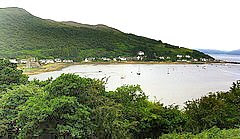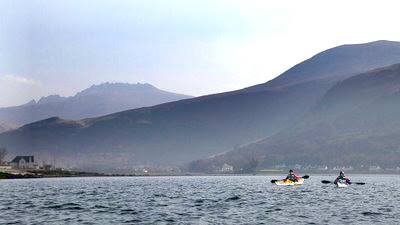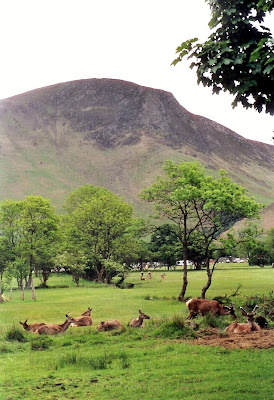 Perhaps the most scenically attractive of Arran's villages, Lochranza is located on the sea loch, Loch Ranza, from which it takes its name. Surrounded on three sides by hills and facing the imposing grey ruin of its castle placed dramatically on a shingle spit sticking into the Loch, a visit is an essential part of any trip to the Isle of Arran.
Perhaps the most scenically attractive of Arran's villages, Lochranza is located on the sea loch, Loch Ranza, from which it takes its name. Surrounded on three sides by hills and facing the imposing grey ruin of its castle placed dramatically on a shingle spit sticking into the Loch, a visit is an essential part of any trip to the Isle of Arran.
A breathtaking view of Loch Ranza, looking west to the castle...with the hills of the Kintyre peninsula beyond.

Lochranza itself lays along both sides of the loch it is named after, though the main focus of activity is on the south western side. The mouth of the loch on this side is home to the ferry slipway, and as you progress along the shore from here you pass a string of cottages, hotels and guest houses and the village hall. Beyond the head of the loch is the field centre, St Bride's Church, a caravan and camping site, and the distillery. The north east side of the loch is home to a narrow road backed
 by cottages, while Lochranza Golf Club occupies the land at the very head of the loch itself. Geographically, Lochranza is very much focused on one of its longer-lived attractions, Lochranza Castle. This is superbly located on a curved shingle spit that projects from the southern side of Loch Ranza. It has been claimed that Lochranza Castle has literary connections, being used as the basis for the castle in the Tintin adventure 'The Black Island'.
by cottages, while Lochranza Golf Club occupies the land at the very head of the loch itself. Geographically, Lochranza is very much focused on one of its longer-lived attractions, Lochranza Castle. This is superbly located on a curved shingle spit that projects from the southern side of Loch Ranza. It has been claimed that Lochranza Castle has literary connections, being used as the basis for the castle in the Tintin adventure 'The Black Island'.

The sight that must must have gladdened the hearts of returning Lochranza seafarers...the castle as seen from the mouth of the sea loch.

It was also the sight that greeted the galleys of invading enemy clans... maybe to make them....think again?

The great rocky ridge of Caisteal Abhail soars above the hills behind the loch. Several granite tors castellate the ridge like battlements and the Gaelic name means 'forked castle'. Caisteal Abhail is Loch Ranza's second castle! Thanks to these hardy kayakers for these great photos - I owe you a drink lads!


Obviously, Lochranza Castle is one of the major attractions within the village, as it is superbly situated on a curved shingle spit that projects out into the water. Much of what can be seen of the castle today is the result of rebuilding in the 16th Century, but there are remnants of the original castle that was built before 1261 for the MacSweens. In 1262 it was granted by Alexander III to Walter Stewart, the Earl of Menteith.
Robert I, King of Scots, better known as 'Robert the Bruce', is said to have landed at Lochranza from Ireland in 1306 at the start of his long struggle to liberate Scotland. The castle was certainly in the possession of his grandson when he became King Robert II of Scotland in 1371. It subsequently saw use as a royal hunting lodge.
 Several further changes of ownership followed, during which the castle slowly became transformed into the tower house we see today. It was also gradually turned to face towards the village rather than the sea.
Several further changes of ownership followed, during which the castle slowly became transformed into the tower house we see today. It was also gradually turned to face towards the village rather than the sea.During the 1490's it was used as a base from which James IV could attack the Lords of the Isles, and his Clan MacDonald. Then in 1614 saw its occupation by James VI; and Cromwell occupied it in the 1650's. Then, following the foreclosure of a mortgage, it found its way in 1705 into the hands of the Hamiltons, like so much else in Arran. It has been disused since the end of the 18th Century.
 The popularity of the ferry route from Lochranza to Claonaig, on the Kintyre peninsula south of Tarbert has helped boost visitors to Lochranza. This provides a "back door" to the island and offers a range of options for those interested in incorporating Arran into a wider tour of Western Scotland.
The popularity of the ferry route from Lochranza to Claonaig, on the Kintyre peninsula south of Tarbert has helped boost visitors to Lochranza. This provides a "back door" to the island and offers a range of options for those interested in incorporating Arran into a wider tour of Western Scotland.
The paddle steamer 'Waverley' calls in at Lochranza during the summer season.
 HM Submarine 'Vandal' Memorial.
HM Submarine 'Vandal' Memorial.Lost at sea on 24th February 1943, the cause of the fate of the Vandal and her crew of four officers and 33 ratings has never been found. The boat anchored at Lochranza on the evening of the 23rd of February 1943 and she left for sea on the morning of the 24th. She was never seen again and she was presumed lost on a deep test dive. The wreck of the Vandal was eventually found in Kilbrannan Sound in June 1994. There was no obvious damage to her hull and the reason for her loss remains a mystery.

The mountainous surroundings also make this an ideal location for golden eagles, while the shore of Loch Ranza is the place to look for the seals that are often on view, and the otters that can sometimes be glimpsed by the more observant.
In slightly more recent times, Lochranza was a major herring fishing port, with the loch sometimes sheltering hundreds of small herring boats at a time. When the herring disappeared, many of the fishermen turned to other forms of seafaring. It is said that more of Scotland's master mariners came from Lochranza than from any other west coast village. *******************************

The village is also home to a specialist field studies centre catering for a wide range of courses including geology, something the north end of Arran has a great deal of.
One final delight remains. Visitors who find their way to Lochranza via the traditional "clockwise" tour of the island, or via the ferry from Kintyre, will be amazed by the sight that greets them as the road crests the end of the glen south of Lochranza on the road to Corrie and Brodick.
Here you are confronted by some of the most jagged, brutal and stunningly impressive mountain scenery anywhere in Scotland. This is on a par with the Cuillin of Skye, but benefits through being smaller in scale and much closer to the road.

let's go inside and inspect the ruins...


we just might beat the rush hour traffic

young deer

old dear

QUACK!QUACK!QUACK! and that's just Carol talking!

Alexander, in his best 'Lord of the Isles' pose, grimaces as he tries vainly to suck in his gut!

This is the Lochranza (par 70) Golf Course. The course is cared for with a view to enhancing the local wildlife. The bird population has doubled since 1990, and there are now 24 species feeding and many nesting within the golf course perimeter. Wild red deer graze the Golf Course throughout the year, with the highest count up to 48. They make their own contribution to the quality of the grass!


We are now at the outer edge of Lochranza by the disitillery...let's pop in for a look around, have some lunch, and just maybe...buy a bottle or two of the excellent Arran whisky!




















No comments:
Post a Comment